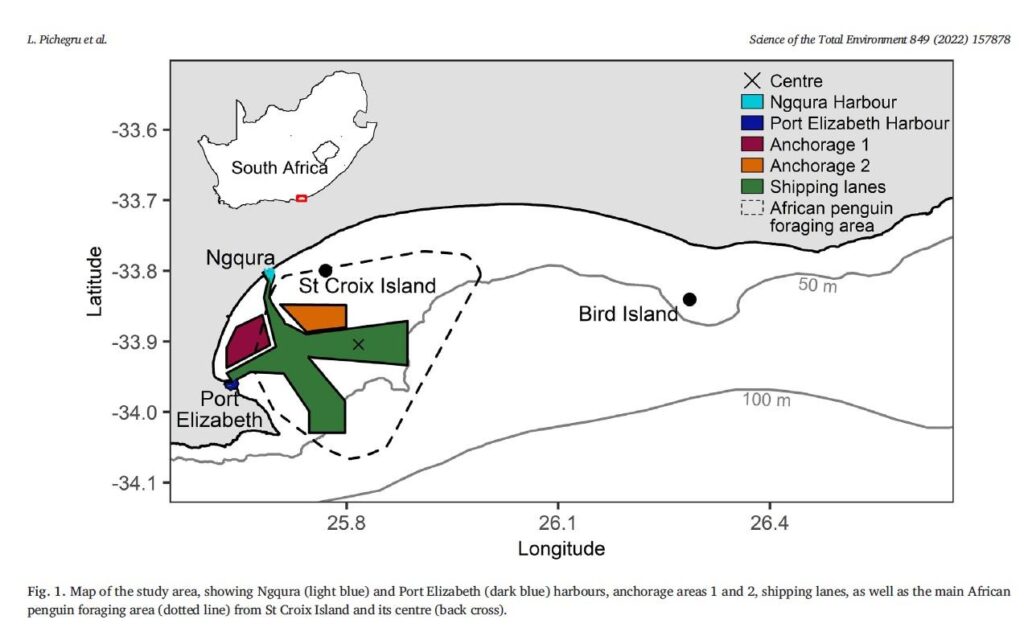With numbers dwindling, scientists are concerned about the future of African penguins. Photo: Renée Bonorchis.
Numbers of breeding pairs in Algoa Bay have bounced back since bunkering stopped
On St Croix Island in Algoa Bay, which is part of the Addo Elephant Marine Protected Area (MPA), there were 7,000 endangered African penguin breeding pairs in 2015. By 2023, the number had collapsed to 700, according to researcher Professor Lorien Pichegru. But the good news is that numbers are rising again – thanks to a tax dispute.
St Croix, only 12 hectares in size and four kilometres from the Port of Coega (Ngqura) couldn’t be in a worse spot. The African penguins on St Croix suffer, says Pichegru, from the double whammy of commercial fishing in the surrounding areas and noise pollution from ships heading in and out of the port.
Pichegru, who is acting director of the Institute for Coastal and Marine Research at Nelson Mandela University in Gqeberha, has been knee-deep in African penguin research for about 15 years. She sometimes lives with them on Bird Island. Pichegru has published nearly 100 papers and been cited more than 2,000 times, according to ResearchGate, and is one of the world’s leading authorities on the species known as Spheniscus demersus (African penguin).
In a study published in 2022 called “Maritime traffic trends around the southern tip of Africa – Did marine noise pollution contribute to the local penguins’ collapse?” Pichegru led a team of eight fellow scientists as they researched the impact of noise in Algoa Bay.
They found that an increase in annual estimated vessel noise corresponded to a significant average decrease of penguin pairs and that the lowest recorded numbers of penguins’ breeding pairs corresponded to the period after ship-to-ship bunkering began in 2016.
Bunkering is a practice whereby ships are refuelled out at sea instead of coming into port. It’s a noisy process and increases the risk of oil spills. And in Algoa Bay all this takes place in or right next to the MPA.

“The intensification of underwater noise levels in the African penguin’s foraging habitat was linked to the initiation and expansion of ship-to-ship bunkering activities which intensified the maritime traffic in the area,” the scientists said in the 2022 paper. “Noise levels were significantly related to the collapse of what had been the world’s largest remaining colony of endangered African penguins.”
Algoa Bay became one of the noisiest bays in the world.

But this year, the number of pairs of penguins, who mate for life, has almost doubled on St Croix. Pichegru, who has just returned from a stay on nearby Bird Island, says the number is up to 1,200 pairs.
This 71% year-on-year jump in numbers, she says, is because there has been no bunkering in the area in the last year. And this is because of a tax dispute. Earlier this year the Eastern Cape High Court heard the case, with the South African Revenue Service (SARS), which confiscated some of the refuelling vessels last year, claiming that illegal bunkering had cost the fiscus as much as R7-billion in lost revenue. The defendants said SARS’s directives about bunkering were unclear. The court found that SARS needed to clarify its regulations, a process that’s still ongoing. While this is ongoing bunkering has stopped, which is good for the penguin population.
But though the news from St Croix is good, Pichegru is still very concerned about the future of the penguins.
An expert panel appointed by former Minister of Forestry, Fisheries and the Environment Barbara Creecy recommended in 2023 various measures to protect penguins.
In August that year, Creecy said the partial ban on commercial fishing for anchovy and sardine around six penguin island colonies, including St Croix would continue unless conservationists and fisheries came to agreements on new fishing bans by the start of this year. With no agreements reached, the partial bans are now in place for the next ten years.
BirdLife South Africa and SANCCOB (Southern African Foundation for the Conservation of Coastal Birds) have challenged this decision in court, saying Creecy did not take into account all the recommendations of the panel. Specifically, they say, she did not take into account recommendations on how to define a “valuable area for African penguins” when considering how to balance penguin needs with fishing industry interests.
As a result, her decision was “biologically meaningless”, they say.
“I do believe penguins have a high risk of becoming functionally extinct by 2035 at the rate they’re going,” Pichegru says. And this is despite the fact that scientists are working to identify the next 5% of South Africa’s ocean that needs protection. At present South Africa has 41 MPAs covering 5.4% of the sea which is under South African law. Like many other countries, South Africa has promised to protect 30% of its sea by 2030.
Given the penguins’ core foraging range, it would be enough to extend the closures out to sea for 40 kilometres at most, says Pichegru. That’s a tiny speck of space when compared to the 1.1 million square kilometres of ocean that fall within South Africa’s exclusive economic zone but would make all the difference to the penguins.
“They can be resilient and have the capacity to produce up to four chicks a year in really good conditions, so they can bounce back should we give them a chance,” Pichegru says. “There is a realistic chance to stop them from disappearing by providing them with adequate protection at sea.”
Renée Bonorchis is a journalist and the founder of The Ocean Advocate, which is co-publishing this story. This is the last in a three-part series. Read part one and part two.






